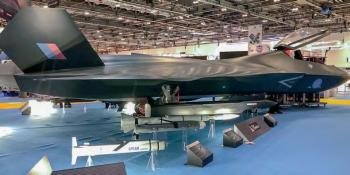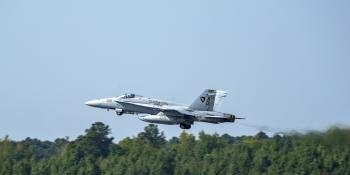Fighter aircraft were not the first heavier-than-air military aircraft. During the First World War bi-planes with a pilot and a crew member would carry out. Guns were soon added to these aircraft and the fighters were born; the term dogfight became synonymous with the new form of aerial combat. These aircraft would also crudely drop bombs with a crew member simply throwing the bombs out of the aircraft. After the First World War, fighter development led to the single wing, enclosed cockpit, propeller powered aircraft such as the RAF Hawker Hurricane, Luftwaffe Messerschmitt Bf 109 and the United States Army Airforce North American Aviation P-51 Mustang. After the war, the RAF Gloster Meteor was the RAF’s first operational jet fighter and it was rapidly joined by fast jets from France, Russia and the USA.
Today, the roles of military fast jets have hardly changed, from intercepting other fast jets fighters or bombers, to maintaining air superiority, they are bombing air defences and photographing bombed sites for battle damage assessment as well as escorting slower, more vulnerable aircraft.
Different Types of Fighter Planes
From the first aerial reconnaissance aircraft, the Wright brothers military flyer, or Model A, sold to the US military in 1909, it took 45 years until the United States Airforce’s North American F-100 Super Sabre became the world’s first operational supersonic fighter in 1954. There has been a huge amount of technological development between the Super Sabre and the world’s first operational fifth generation fighter, the United States Marine Corp’s Lockheed Martin F-35B/C Lightning II, which entered service in 2015. All fixed wing aircraft, since the advent of jet fighters in World War Two, have been a variety of designs to meet the military’s changing needs. Jet engines were in development before World War Two, but it was only near the end of that war that the first operational fast jet fighter, the Messerschmitt Me 262, took to the skies.
Fighters steadily developed to fly higher and faster, carry more payloads, both missiles and bombs, and became supersonic. The need for greater speed saw the delta wing shape for supersonic flight, air-to-air missiles were used in the Korean War for the first time, and it was only later that fighters were equipped with radar, allowing for longer range interception. The 1960s saw the development of vertical take-off and landing (VTOL) capability with the Royal Navy’s Hawker Siddeley Harrier, which is still in service with the Indian military. Propeller powered fighter aircraft did not end with the flights of the Gloster Meteor and the 1950s saw experiments with VTOL propeller powered aircraft that sat on their tails in a vertical position.
Since the 1980s fast jets have become stealthy, first with the now retired Lockheed Martin F-117 Nighthawk which was primarily a bomber, to the Lockheed Martin F-22 Raptor, an interceptor, and the multirole Lockheed Martin F-35, which are both said to have very small radar signatures.
Find out more about other types of Military Aircraft
Want to read more about Airforce News, Military Transport Aircraft, Military Aircraft Show, Military Aircraft Technology?
Subscribe to Key.Aero
Become a part of our aviation community and subscribe to Key.Aero now. You can get all the aviation information you'll ever need, whenever you want, with access to all the latest aviation updates, news, events and more.
![Rafale F3Rs [Armee de l'Air/ via Dave Allport] Thumbnail](https://fullfatthings-keyaero.b-cdn.net/sites/keyaero/files/styles/listing_card/public/2019-10/07_europenews.jpg?h=b196efe9&itok=91VGSFmO)
![51 Stormo F-2000A [Marco Rossi] Thumbnail](https://fullfatthings-keyaero.b-cdn.net/sites/keyaero/files/styles/listing_card/public/2019-10/02_europenews.jpg?h=d3f64e0b&itok=1TM17-9q)
![AMX [Marcus Vallianos] Thumbnail](https://fullfatthings-keyaero.b-cdn.net/sites/keyaero/files/styles/listing_card/public/2019-10/01a_europenews.jpg?h=74328444&itok=zXCa0EdD)

![HAL LCA Navy [HAL] Thumbnail](https://fullfatthings-keyaero.b-cdn.net/sites/keyaero/files/styles/listing_card/public/2019-10/hal_lca_navy_hal_1.jpg?h=190f4286&itok=os2vv2Nb)

